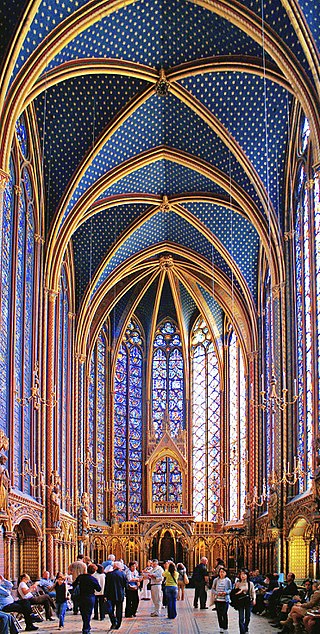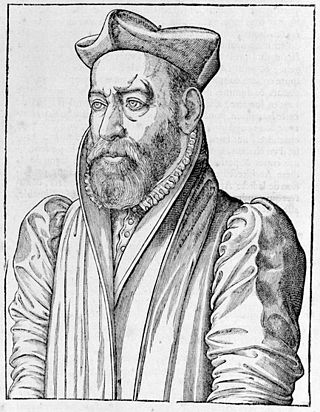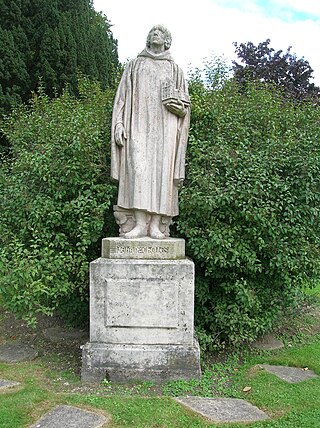
Villard de Honnecourt was a 13th-century artist from Picardy in northern France. He is known to history only through a surviving portfolio or "sketchbook" containing about 250 drawings and designs of a wide variety of subjects.

The Sainte-Chapelle is a royal chapel in the Gothic style, within the medieval Palais de la Cité, the residence of the Kings of France until the 14th century, on the Île de la Cité in the River Seine in Paris, France.

Philibert de l'Orme was a French architect and writer, and one of the great masters of French Renaissance architecture. His surname is also written De l'Orme, de L'Orme, or Delorme.

The Musée de Cluny, officially Musée de Cluny-Musée National du Moyen Âge, is a museum of medieval art in Paris. It is located in the 5th arrondissement of Paris, bordered by square Samuel-Paty to the south, boulevard Saint-Michel to the west, boulevard Saint-Germain to the north, and rue Saint-Jacques to the east.
The canton of Lorris is a canton of the Loiret département, in the Centre-Val de Loire région of France. 37 of its 38 communes are part of the arrondissement of Montargis.

The arrondissement of Bernay is an arrondissement of France in the Eure department in the Normandy region. It has 297 communes. Its population is 227,054 (2016), and its area is 3,226.7 km2 (1,245.8 sq mi).

The arrondissement of Mayenne is an arrondissement of France in the Mayenne department in the Pays de la Loire region. It has 132 communes. Its population is 120,982 (2016), and its area is 2,961.8 km2 (1,143.6 sq mi).
Rue de l'Abbaye is a commercial street in the 6th arrondissement of Paris, named after the Abbey of Saint-Germain-des-Prés. It has a length of some 170m and runs from the Rue Guillaume Apollinaire to the Rue de l'Echaudé. The street itself dates from 1800 although the land it runs over has a much longer history.

48°51′14″N2°20′04″E

The Château de Saint-Germain-en-Laye is a former royal palace in the commune of Saint-Germain-en-Laye, in the département of Yvelines, about 19 km west of Paris, France. Today, it houses the musée d'Archéologie nationale.

Louis Métezeau was a French architect.

Jeande Chelles was a master mason and sculptor who was one of the architects at the Cathedral of Notre-Dame de Paris. On the exterior wall of the south transept a stone plaque is signed Johanne Magistro and dated February 1257, documenting the initiation of alterations to the transept and its portal. On his death in 1265, he was succeeded by Master Pierre de Montreuil.

Jean Beausire was an architect, engineer and fountain-maker and the chief of public works in Paris for King Louis XIV of France and King Louis XV of France between 1684 and 1740, and was the architect of all the public fountains constructed in Paris that period. Several of his fountains still exist and continue to work. Three streets in the 4th arrondissement of Paris today carry his name: Rue Jean-Beausire, Impasse Jean-Beausire, and Passage Jean-Beausire.
This page lists the armoury of the communes in la Vendée.

Jean-Baptiste-Antoine Lassus was a French architect who became an expert in restoration or recreation of medieval architecture. He was a strong believer in the early Gothic architecture style, which he thought as a true French and Christian tradition, and was opposed to the classical Graeco-Roman styles promoted by the academic establishment.

Jean-Marie Valentin, was born at Bourg-des-Comptes in Ille-et-Vilaine on 17 October 1823 and died in Paris on 8 August 1896. He was an architect and a sculptor specialising in religious furnishings such as pulpits, altars and statues. His father Antoine Louis Valentin was a master carpenter working mostly in ebony. He was born in 1784. Jean-Marie first worked at his father's workshop.
The canton of Luneray is an administrative division of the Seine-Maritime department, in northern France. It was created at the French canton reorganisation which came into effect in March 2015. Its seat is in Luneray.
Eudes de Montreuil was a 13th-century French master builder, sculptor and combat engineer. He may have died in 1289.













